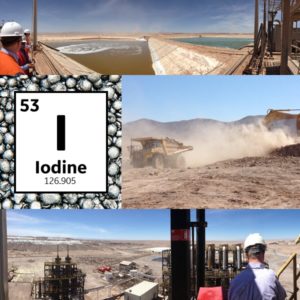Brought to you by GE Healthcare
The discovery of iodine as a radio-contrast agent was accidental. In the early 1920s, when iodine-containing compounds were used to treat syphilis, Osborne et al. observed that the urine of patients treated with iodine was radiopaque; they went on to perform the first successful clinical pyelogram in 1923 at the Mayo Clinic. From this point on, iodinated contrast was used in increasing imaging applications. Today, iodinated contrast media is used in over 100 million procedures annually.
Iodine is the main ingredient of iodinated contrast constituting approximately 50% of its molecular weight. Iodine is a nonmetallic element belonging in the halogen family in diatomic form [there are always two atoms of iodine together (I2)], and therefore, cannot be chemically reproduced. The halogen family includes bromine, chlorine, and astatine, all elements that can be applied interchangeably for scientific and commercial use, although not all applications can be substituted. This is the case specifically for X-ray contrast media – to date only iodine is used in X-ray radio-contrast agents.
The use of iodine for iodinated X-ray contrast media accounts for 28% of the yearly iodine used. The iodine used for contrast media must be of pure form, free of impurities and derivatives and other compounds; this pure form is needed for contrast media and pharmaceutical applications.
Iodine is rare and found naturally in seawater, seaweed, brine water, and in specific geologic formations in parts of the world. Much of the world’s raw iodine is found in Chile and Japan, with the largest deposits found in the Atacama Desert of Chile. The Atacama provides a unique method of extracting iodine through mining and heap leaching, while many other iodine deposits, such as the ones in Japan, require drilling and brine extraction.
We may take for granted the importance of this main active pharmaceutical ingredient (API) – Iodine. A world depleted of iodine would be catastrophic for the practice of medicine. Without iodine, we would alter the ability to diagnose using computerized tomography or treat medical conditions using interventional or vascular procedures. As a result, it is very crucial that we prioritize effective measures to curtail the depletion of iodine such as recovery and recycling.

API recovery has been put in place by certain contrast media manufacturers for some time now. With API recovery, rather than disposing of expired contrast media from warehouse inventory, it is instead shipped back to the manufacturing facility that would recover the API and reuse it back in the manufacturing process. Healthcare institutions are also actively encouraged to send back expired contrast media so that the same process can be followed. Although, rarely in practice do healthcare institutions let the product expire as most sites are very effective at maintaining constant flow to utilize products before expiry. API recovery only works with unused and unopened bottles of contrast media.
Another way that sites in Canada can help do their part is with Iodine recycling. This new process allows sites to recycle any unused product that might be left behind in open contrast media bottles as well as contrast media that might be leftover in a syringe. These are two areas where the product has not been contaminated by any bodily fluids from the patient. With iodine recycling, we are preventing product from being thrown out where the product may be incinerated or thrown down the drain. This also potentially reduces waste management costs for the healthcare institution. The recycled contrast media is collected in a container which is then sent back to the contrast media manufacturing facility where it is processed to extract the iodine and purify it. The pure iodine is then used in the manufacturing process again to create new vials of contrast media.
Now knowing the consequences of iodine depletion in the world and knowing that there are resources to help curtail this right here in Canada, it is arguably the responsibility of both contrast media manufacturers and healthcare institutions to value the recycling or recovery of this API. How can you help? Make this issue known across your peers and research if your contrast media provider prioritizes this initiative and offers this service. The future efficacy of diagnostic imaging depends on it.
